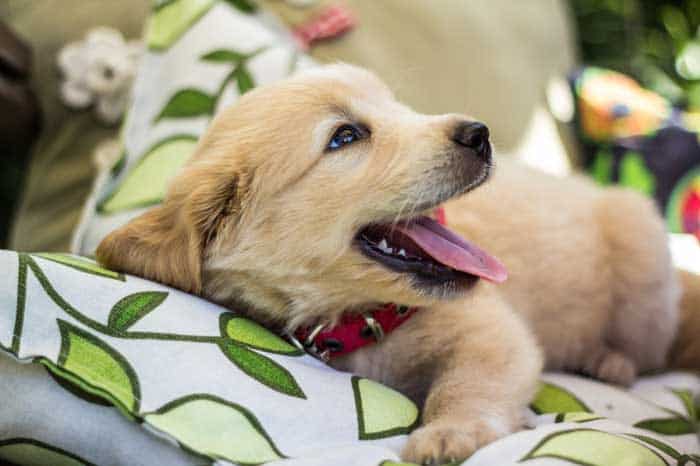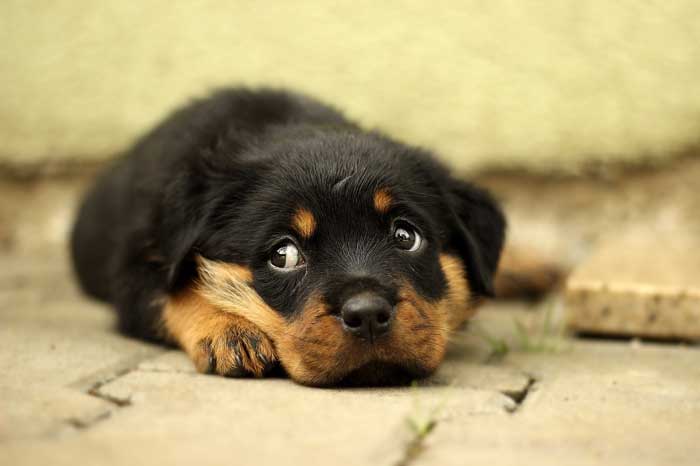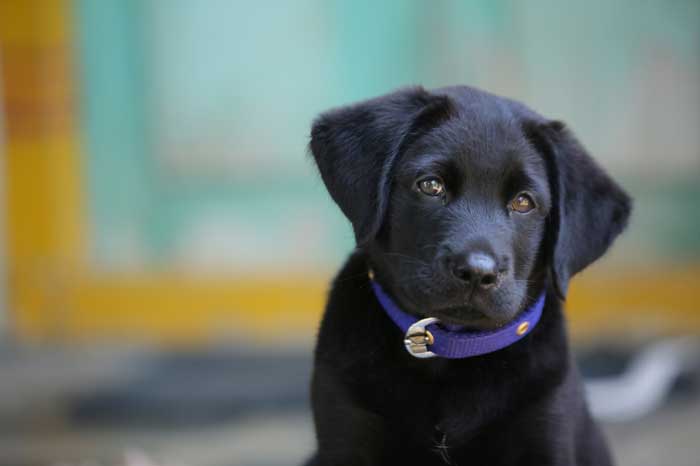Although none of us would want to leave a newly-adopted puppy for even a minute, it’s simply impossible!
Leaving a puppy home alone for the first time can be filled with a lot of stress. If not provided with the right training, a young puppy can dwell on anxiety and end up chewing every bit of the house.
The good news is, there are 10 simple tips that can make your sociable dog stay alone quietly until you come back.
But be aware, not all puppies can be left alone for long periods. Make sure to stick till the end of this article where I’ll discuss this in detail.
1. First Things First, Puppy-Proof Your Home
Before proceeding with the rest of the tips, it’s extremely important to make sure your home is safe enough for un-attended puppies.
Cover or Remove Wires
Ground wires are on top of the hazards list. Chewing on them can cause anything from burns to electric shocks, let alone the property damage.
Your best bet would be wire protectors. These act like a safe-to-chew defensive line. But to be safe, take all the wires out of your puppy’s reach. Elevate them, hide them under low furniture, or even unplug what you don’t need.
Secure the Trash
Canines are scavengers by nature, even a hunting dog breed. If your puppy saw you enjoying delicious “human food”, his curious nose would push him to scavenge the remains from the trash.
The worst thing about garbage is that you can’t always predict or trace its effects. Your dog may experience usual gastrointestinal problems, like diarrhea or vomiting.
However, it can also lead to more serious problems such as physical obstruction, suffocation, or severe toxicity.
To prevent these problems, purchase a pet-proof garbage can. It should filter all odors and have a secure lid. It’d be perfect if you can put it in a corner so your pup won’t be able to flip it.
Fix Fence Holes
If you decide to let your new puppy out in your yard, make sure your fence doesn’t have any small holes. It doesn’t have to be large enough for the pup to fully pass through. Curious pups can injure themselves by wiggling through the smallest areas.
Protect Any Chewable Items
No one wants to get mad with those little, furry puppies. But sometimes you can’t help it, especially after your young pup wrecks havoc on your home.
Protect all the small items that can be easily chewed or broken. These include remote controls, sculptures, vases, clothes, etc. Additionally, remove small decorations that could be easily swallowed by your dog.
2. Don’t Let Your Puppy Become Overly-Dependant

Who wouldn’t want to spend every moment playing with these adorable furry friends? It feels absolutely charming! However, it’s one of the most harmful behaviors that can mess up your dog’s personality and predispose him to be an anxious dog.
Why? Well, dogs are super affectionate. When you give them continuous attention, they become fully dependent on you as their one and only source of happiness and confidence.
Therefore, when you leave them, they feel that their world is collapsing, so they freak out. Actually, this is a pretty famous problem known as separation anxiety.
A dog suffering from separation anxiety might show the following symptoms when you’re not by his side:
- Excessive whining, howling or barking
- Frequent and profuse drooling
- Destructive behavior to the surroundings, like scratching or chewing
- Repeated pacing, especially around the door
- Multiple indoor accidents, even if he’s properly housetrained
To avoid these issues, your dog must understand that he can be happy without you. This can be achieved through things like crate training.
3. Consider Crate Training to Minimize Dependence
Some owners think it’s cruel to enclose their delicate puppies in crates. They feel guilty and instantly give up after the puppy starts whining or looking at them with his cute eyes.
They feel they’re doing their dog a favor by letting him free. But in reality, they’re kind of spoiling him. Think about puppies as babies. If they learn to associate whining and crying with rewards from you, they’ll behave likewise for the rest of their lives.
So, you need to be a little tough against those soft whines. However, make sure that you purchase a crate that’s big enough for your puppy, and even consider that he can use it when he is an adult dog.
He has to fully stand up and lift his head without touching the top. Also, he must be able to turn comfortably without interfering with the sides. If your house allows it, it’ll be great if he can walk inside even a little bit.
How Do Crates Help With Separation Anxiety?
Wolves, the oldest ancestors of our lovely friends, like to stay in dens. That’s where they feel relaxed and secure. Dogs may be more playful than wolves, but they share this trait with them.
Remember what I explained in the previous section? Your puppy needs to feel happy and confident when he’s not around you. That’s what a crate or a kennel does.
Slowly familiarize your pup into the crate to decrease the likelihood of whining. Make him spend small periods at first, and then gradually increase the time.
Feed him inside the crate. Try a suntheanine-containing kibble; this substance helps to naturally soothe the dog. Give him his favorite chew toy or blanket so he can occupy his mind.
And as we established, never let him out to reward his whining. Instead, go to another room until he stops, and then return to let him free.
In fact, when your puppy becomes comfortable enough inside the crate, he’ll voluntarily enter to rest or relieve stress.
Nevertheless, make sure you don’t overdo it. Here are the maximum hours that puppies can spend inside a crate without long-term damage:
- 8-10 weeks: 30 to 60 minutes
- 11-14 weeks: 1 to 3 hours
- 15-16 weeks: 3 to 4 hours
- 17+ weeks: 4 to 5 hours
4. Keep Him Confined

Unless you want to clean accidents around the whole house, you shouldn’t let your puppy roam freely around the house.
It’s not all about your convenience, though. No matter how well you puppy-proof your home, a curious puppy may find his way around and injure himself. Therefore, confining him in one area is crucial for his safety, at least until he’s well-trained.
I don’t prefer using a dog crate for this. Your dog needs to move his body to stay healthy and fight stress.
The next best thing is a playpen. It’s basically a big crate with an open roof. If you don’t have enough space, then you’re left with dog gates. These are great to keep your pup from going upstairs/downstairs, for example.
Oh, and please, do yourself a favor and don’t use potty or pee pads to line the confinement areas. Yes, they do make cleaning much easier. But they also make the overall potty training a lot harder!
Think about it. When your puppy starts potty training he will learn to only pee outside because he recognizes the smell and the appearance of the surroundings. But he can’t really understand the difference between a puppy pad and the floor.
Therefore, when you let him pee on these pads, you’re actually teaching him that it’s fine to pee inside the house, wherever and whenever he wants!
5. Return Without Rewards and Leave Without Cues
Ever heard about Pavlov’s experiment? Ian Pavlov was one of the most famous Russian physiologists. He was among the first to explore dog responses.
In his most famous work, he found that a dog naturally salivates before feeding. He then tried to click a metronome before serving food.
After several times, the dog salivated in response to the metronome, even without the sight or the smell of food. This is the scientific concept of clicker training, by the way.
You Might Be Encouraging Your Puppy’s Anxiety!
No matter how hard you try, your dog might have separation anxiety. It can be mild that it doesn’t manifest in behavior, but that doesn’t mean it’s not there.
That’s why it’s super important to return home silently and proceed normally with your daily routine.
If you instantly flood your puppy with love after you open the door, he’ll condition the anxiety that he might have with your love. This can even push him to intentionally throw a fit for your attention.
Similarly, try to minimize the noise you make before leaving. Keep an eye on your puppy and notice how he reacts to what you’re doing. If you find that a certain action, like putting on shoes or picking up the keys, induces his stress, then do it and don’t leave.
This will break any conditioning he might have before developing into a well-established habit.
6. Do Test Runs
Later on in this article, we’ll discuss how you can see what your pet is up to in real-time. But before actually leaving your dog alone, running test runs can be helpful to know how he’d react.
It’s important to exactly do what you’re planning to do in the real thing. Put on your clothes, leave your pup in his designated area, pick up your keys, etc. Get out and stand behind the door to hear if he whines or scratches.
Then, go back inside after about 5 minutes. Gradually increase the time until you reach the maximum time recommended for your dog’s age. Not sure what is it? Check the last section where I explore this in detail.
This way, you guarantee a full stimulation to your dog’s senses to know what might stress him.
7. Make Sure He’s Tired

I’ve always heard my grandfather saying, “A tired dog is a good dog.” Although he didn’t come up with this, I couldn’t agree more.
If your time allows, take your pup for a brisk exercise just before you go out. You could play fetch, run around, or even take a small walk. Do anything to exhaust him enough to be a couch potato. Otherwise, he’ll take his energy out on your poor house and furniture!
8. Make Sure His Mind Is Tired, Too
Keep your puppy’s mind occupied with interactive toys. A treat-dispensing ball can go a long way in stimulating your puppy’s mind and body.
A chewer is also essential. It will keep your dog’s teeth powerful and healthy. Not to mention that your furniture will be extremely grateful!
9. Make He Feel Like You’re There
Alright, it’s time for the big day. It’s totally fine to be stressed about it. But make sure this stress doesn’t affect how well you handle the situation.
So, back to your doggy. He must feel like you’re with him in the house somewhere, he just can’t see you. You can do that by leaving the TV on, playing some soothing music, or leaving some of your old clothes for your dog to snuggle with.
Puppies can be afraid of complete darkness. Therefore, if you’re leaving in the morning and don’t plan to return before night, don’t forget to turn on the lights.
Last but not least, closing the windows can shield your puppy from noisy neighbors, honking cars, scary thunder, etc.
10. Make Sure He Eats on Time
Puppies need to be fed 3-4 times a day on average. You’ll most likely miss at least one meal if you’re going out for work. This won’t only jeopardize their growth, but it’ll also build up their stress.
Some people like to leave a full bowl so the puppy can eat whenever he wants, but I strongly advise against that. Just like humans, dogs can soothe their stress by overeating. A chubby puppy may look cuter, but he certainly won’t be as happy.
Solution? An automatic dog feeder. It’s like a small robot that dispenses food according to a pre-programmed schedule.
Some products go the extra mile and record your voice to play it back as your puppy eats. Food and love, could it be any better!
11. Stay on Top of What He’s Doing When He’s Home Alone

Let’s be honest, even after going through all this effort to prepare your dog, you might have a small bit of guilt and anxiety lurking inside you. Carrying on with a normal workday can be extremely difficult this way.
If this is how you feel, a pet camera can give you the peace of mind you need.
These cameras work via wifi. They broadcast a live stream of your home to your smartphone. They can have some cool, helpful features like:
- Motion tracking, to know when your dog is stressfully pacing
- Sound detection, to know if he whines or barks
- A speaker, to calm your dog by talking to him
- 360-view, to scan the whole room
Best of all, such a camera would also be useful as a security camera to know if someone breaks in. It’s totally a bang for the buck!
When Is It OK to Leave a Puppy Alone?
Don’t rush to apply the mentioned tips just yet. Not all puppies can be safely left home. In this section, I’ll review every puppy age to know how much time they can stay alone.
Nevertheless, these estimations may vary according to your puppy’s personality and breed. So it’s better to gradually increase the alone time instead of going with the highest value right away. This way, you can evaluate your puppy’s response and take action when needed.
Below 8 Weeks
A puppy at this age needs you the most. He’s physically and emotionally fragile. Therefore, he shouldn’t be left alone at all.
If you absolutely have to leave, you can leave him at your friend’s or neighbor’s home. If nothing works, make sure he’s not alone for more than 30 minutes.
8 to 10 Weeks
You can leave your pup alone for an hour starting from this age. It’s important to know that their tiny bladders won’t be able to hold it much longer. So don’t be upset if you found some accidents.
Moreover, it’s better to keep him in a small confined area, like a playpen, to ensure safety.
10 to 12 Weeks
If you provide the necessary training, your dog should be learning self-independence by now. However, accidents can still happen. So don’t leave your puppy longer than 2 hours.
At this age, your pup can get out of the playpen to stay in a hard-floored room. It’s better not to place a carpet to easily-clean the possible accidents. You can also use baby gates to allocate a larger area.
3 to 6 Months
As a rule of thumb, puppies in this age group can be left alone an hour per each month of age. For example, a 5-month puppy can be left alone for 5 hours, while a 3-month old can only be left for 3 hours.
Accidents should be a lot less around this time, but they’re still inevitable.
6 to 12 Months
Don’t leave your pup for more than 6 hours by this age. He should be able to avoid accidents to a big extent.
If your dog is still experiencing accidents frequently, you can mildly apply negative reinforcement. Don’t attempt to punish your pup, though.
12+ Months
Most dog breeds complete their physical maturation around a year of age. This means that your dog will be stronger and more active. Therefore, it’s extremely important to provide him with regular exercise.
Otherwise, your dog will start to show extreme symptoms of separation anxiety. You might come home to find a chewed door or a broken table.
In this case, it’s better to consult a professional trainer. This would be a lot easier and faster than dealing with it on your own.
Final Thoughts
Safety, independence, crate-training, exercise, and a calm environment are among the most important requirements for leaving your dog home alone for the first time.
Remember, dogs are super-intelligent. Even if they don’t respond well right away, it’s important as a dog owner to stay patient and keep trying.
If your dog doesn’t make any progress, he might be suffering from a severe case of separation anxiety. In this case, take him to a vet, he might get better with the help of some drugs.
Lastly, I wish you the best of luck with your charming ball of fur!

